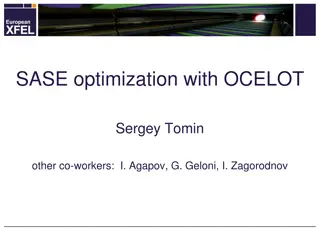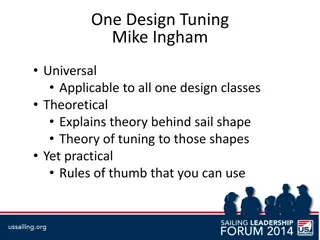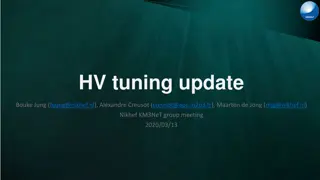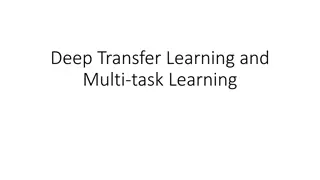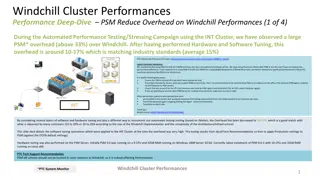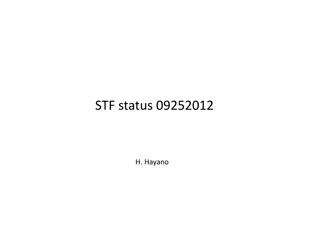Enhancing High Energy Physics Research Through Analysis Preservation and Generator Tuning
Delve into the world of high-energy physics with a riveting journey through the analysis preservation and tuning of hadronic interaction models. Learn about the motivation, goals, and processes involved in making research results accessible, publicly available, and reproducible. Explore the tools and repositories utilized in the preservation of experimental data and the enhancement of analysis for generator tuning, ultimately contributing to the transparency and impact of scientific analyses.
Download Presentation

Please find below an Image/Link to download the presentation.
The content on the website is provided AS IS for your information and personal use only. It may not be sold, licensed, or shared on other websites without obtaining consent from the author. Download presentation by click this link. If you encounter any issues during the download, it is possible that the publisher has removed the file from their server.
E N D
Presentation Transcript
A RIVETing journey: Analysis Preservation and Generator Tuning in High Energy Physics Johannes Albrecht, Hans Dembinski, Lars Kolk Workshop on the tuning of hadronic interaction models Wuppertal, 24.01.2024 Lars Kolk
Motivation Goal: Make paper results more accessible/usable Make results publicly accessible Provide results in machine readable format Provide interface for generator tuning Archiving published analyses for public access Promotes transparency and reproducibility Increases impact of the analysis/paper Improves utilisation of analysis for generator tuning Analysis preservation 1. Data: HEPdata 2. Analysis Code: Rivet LHCb Collaboration, JHEP 01 (2022) 166 Lars Kolk 2
HEP Generator tuning in a nutshell Tuning software Event generator with tuning interface RIVET Accelerator data Modified from H. Dembinski Lars Kolk 3
Analysis Preservation Roadmap Initiate HEPData submission Use HEPData output to develop RIVET plugin Publish Analysis Internal Reviews/Merge into Rivet ??? Profit! Lars Kolk 4
HEPDATA Lars Kolk 5
HEPData HEPData: Open-access repository used to preserve and share experimental data Maintained by CERN Huge catalogue of preserved analyses Ensures long-term preservation of experimental results HEPData Entries Can be searched via many categories Come with abstract and proper citation Store data in tables Lars Kolk 6
Example HEPData entry Lars Kolk 7
Example HEPData entry Lars Kolk 8
HEPData-Submissions Each submission consists of One submission.yaml Links to every table in the submission Provides metadata for the HEPData entry One .yaml file for every table in the entry Contain data points, errors Refer to documentation or previously uploaded entries : ) Contact your coordinator to initiate a submission Use hepdata-validator or HEPData sandbox to validate your files Lars Kolk 9
HEPData-Submissions Each submission consists of One submission.yaml Links to every table in the submission Provides metadata for the HEPData entry One .yaml file for every table in the entry Contain data points, errors Refer to documentation or previously uploaded entries : ) Contact your coordinator to initiate a submission Use hepdata-validator or HEPData sandbox to validate your files Lars Kolk 10
RIVET Lars Kolk 11
Rivet Rivet: Most widespread way by which analysis code from the LHC and other high-energy collider experiments is preserved. Used for generator tuning Provides set of experimental analyses Rivet wishlist, installation Analysis name: <Experiment>_<publication_year>_I<InspireID> E.g.: LHCB_2021_I1889335 Each Rivet-analysis consists of one .cc file containing the analysis code .yoda file containing the data points (from HEPData) .info file containing metadata .plot file setting plotting options Lars Kolk 12
Rivet Analysis Code An analysis is usually written in one .cc file containing A no-argument constructor Three analysis event loop methods: 1. init: book histograms, initialise counters, etc. 2. analyze: per event: select particles, apply cuts, construct observables, fill histograms etc. 3. finalize: normalize/scale/divide histograms, tuples, etc. A minimal hook into the plugin system Projections: observable calculator objects that are called by the analysis' apply(event) method. Refer to projection declared in init method Compiled via rivet-build <NAME>.cc Generates a RivetAnalysis.so file Lars Kolk 13
Rivet Analysis Code An analysis is usually written in one .cc file containing A no-argument constructor Three analysis event loop methods: 1. init: book histograms, initialise counters, etc. 2. analyze: per event: select particles, apply cuts, construct observables, fill histograms etc. 3. finalize: normalize/scale/divide histograms, tuples, etc. A minimal hook into the plugin system Projections: observable calculator objects that are called by the analysis' apply(event) method. Refer to projection declared in init method Compiled via rivet-build <NAME>.cc Generates a RivetAnalysis.so file Lars Kolk 14
Rivet Analysis Code An analysis is usually written in one .cc file containing A no-argument constructor Three analysis event loop methods: 1. init: book histograms, initialise counters, etc. 2. analyze: per event: select particles, apply cuts, construct observables, fill histograms etc. 3. finalize: normalize/scale/divide histograms, tuples, etc. A minimal hook into the plugin system Projections: observable calculator objects that are called by the analysis' apply(event) method. Refer to projection declared in init method Compiled via rivet-build <NAME>.cc Generates a RivetAnalysis.so file Lars Kolk 15
Rivet Analysis Code An analysis is usually written in one .cc file containing A no-argument constructor Three analysis event loop methods: 1. init: book histograms, initialise counters, etc. 2. analyze: per event: select particles, apply cuts, construct observables, fill histograms etc. 3. finalize: normalize/scale/divide histograms, tuples, etc. A minimal hook into the plugin system Projections: observable calculator objects that are called by the analysis' apply(event) method. Refer to projection declared in init method Compiled via rivet-build <NAME>.cc Generates a RivetAnalysis.so file Lars Kolk 16
Rivet Analysis Code An analysis is usually written in one .cc file containing A no-argument constructor Three analysis event loop methods: 1. init: book histograms, initialise counters, etc. 2. analyze: per event: select particles, apply cuts, construct observables, fill histograms etc. 3. finalize: normalize/scale/divide histograms, tuples, etc. A minimal hook into the plugin system Projections: observable calculator objects that are called by the analysis' apply(event) method. Refer to projection declared in init method Compiled via rivet-build <NAME>.cc Generates a RivetAnalysis.so file Lars Kolk 17
Running and submitting a Rivet-plugin You can run your compiled code via rivet -a <Name> <inputfile> inputfile: .hepmc file Style: .plot file Rivet provides example files to test on Alternative: Let your favourite generator generate some events for you! Produces Rivet.yoda file Plotting: rivet-mkhtml --errs Rivet.yoda Outputs look sane Internal Review /MR in RIVET 103MB events - LHC-13-Minbias.hepmc.gz Lars Kolk 18
Running and submitting a Rivet-plugin You can run your compiled code via rivet -a <Name> <inputfile> inputfile: .hepmc file Style: .plot file Rivet provides example files to test on Alternative: Let your favourite generator generate some events for you! Produces Rivet.yoda file Plotting: rivet-mkhtml --errs Rivet.yoda Outputs look sane Internal Review /MR in RIVET 106MB events - Gauss v56r4 provided by A. Grecu Lars Kolk 19
Additional Remarks Lars Kolk 20
Analysis Preservation Guide Written Analysis Preservation Guide, including all important steps Lars Kolk 21
Connection to SFB1491 F3 & F4 Deliverables: Selected LHCb analyses will have been adopted for the use with Rivet Provide plugins for generator tuning in (astro)-particle physics Several rivet plugins written by Chlo , e.g. NA61SHINE_2019_I1754136 HARP_2008_I778842 HARPCDP_2010_I863735 LHCB_2011_I891233 Pion/Kaon/Proton projectile against carbon target in forward rapidity regions Lars Kolk 22
Summary Archiving published analyses for public access Promotes transparency and reproducibility Increases impact of analyses Analyses can be archived Data: HEPData Code: Rivet Preservation procedure shown by example LHCB_2021_I1889335 Written guide to help with analysis preservation Rivet plugins are important deliverables for the SFB Rivet plugins can be used by anybody s generators based off your results! Lars Kolk 23






